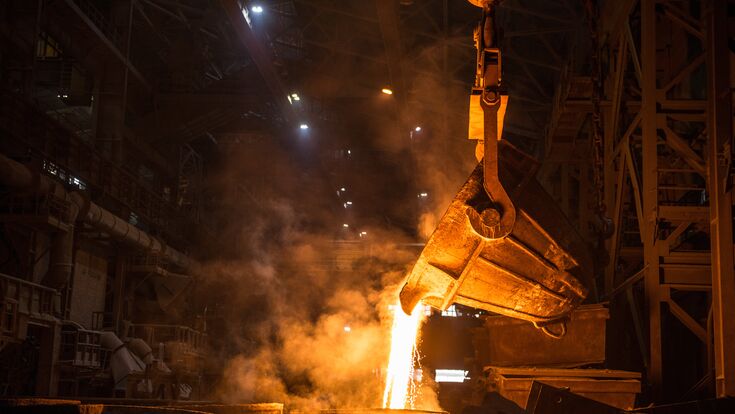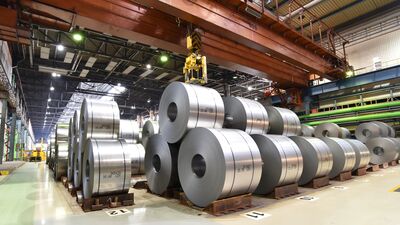Metal Recycling : Green Steel: A key solution for environmental conservation

Both the scrap and metal recycling industry are key sectors that contribute significantly to the global economy and sustainability efforts. Recently, these industries have faced various challenges and opportunities that have shaped their current state.
The past year has been particularly turbulent for base metals, with significant volatility affecting the global scrap industry. The London Metal Exchange (LME) serves as a barometer for metal prices, which have been relatively stable, but have shown a downward trend for some metals. In particular, recent fluctuations in copper and aluminium stocks on the LME reflect wider industry trends and highlight the complexity of market dynamics.
In Europe, non-ferrous metal markets are facing significant challenges, as evidenced by the VDM Business Climate Index, which reflects a pessimistic outlook among metal traders and recyclers. Despite some optimistic indicators, such as expectations of economic improvement, overall sentiment remains subdued.
Market sources expect a solid first quarter, although challenges remain, such as the impact of the Red Sea crisis. Attacks on merchant vessels by Houthi rebels in Yemen have forced shipping lines to divert their fleets around the Cape of Good Hope, adding around nine days to a typical voyage from Taiwan to the Netherlands.
The market for containerised shredded scrap has also been affected, with container freight rates for exports from the UK and Europe to India almost doubling in a month, making imports of such scrap unprofitable for Indian buyers.
Prices for Turkish imports of ferrous scrap have also risen sharply, reflecting tight supplies and increased collection costs in certain regions.
Related article: "All steel is recyclable whether it’s packaging, a car or a bridge"
Green Steel
Steel is traditionally produced in carbon-intensive processes using coal or natural gas. According to the International Energy Agency's (IEA) Iron and Steel Technology Roadmap for 2020, the steel industry is responsible for around 5% of CO2 emissions in the EU and 7% globally. But the potential to decarbonise steel is immense and mature technologies are available. It's important to note that near-zero emissions steel, colloquially referred to as "green steel", requires a technology shift from current practices to processes where emissions are either captured or avoided altogether, for example through electrification or the use of renewable hydrogen.
Steel also has one major advantage: it can be recycled endlessly without degradation. And there is no shortage of steel scrap, according to EuRIC, the umbrella organisation for the recycling industry in Europe. According to the organisation, the availability of recycled steel scrap has structurally exceeded domestic (EU) demand for the past two decades. As a result, there has never been and there is no shortage of steel scrap in the EU. “Provided the right policy framework is maintained, there will be no problem to ‘access’ steel scrap in the foreseeable future”, EuRIC says.
The European recycling industry recycles on average more than 100 million tonnes of steel per year, according to EuRIC. 80% of this is used domestically by European steelmakers, while around 20% is exported, mainly to countries that rely on the electric arc furnace (EAF) route (secondary steelmaking) for their steel production. With the largest built EAF capacity, Turkey remains the world's largest importer of recycled steel scrap.
However, the 20 million tonnes of recycled steel scrap that goes into export must be seen in the context of the 128.9 million tonnes of iron ore that the EU imports annually in 2021 to make steel from countries such as Brazil, where mining contributes to deforestation and biodiversity loss.
The use of recycled steel scrap in the EU falls from 102.2 million tonnes per year in 2005 to 87.9 million tonnes in 2021. This decrease is fully proportional to the decrease in crude steel production in the EU from 182.3 million tonnes to 152 million tonnes over the same period. As a result, the use of recycled steel scrap in the EU remains at the same level of +/-57% on average, while it reaches 70% in Turkey and the US, which rely mainly on secondary steel production.
The EU is therefore lagging when it comes to green steel. “Around 60 per cent of EU steel is made via the energy- and CO2-intensive blast furnace process, and 40 per cent from recycled steel scrap in electric arc furnaces”, says EuRIC. “In stark contrast, the United States or Turkey have opted for the greenest route to produce steel with more than 70per cent of steel produced via EAF, the remaining via BOF.”
The industry association therefore calls for a number of key policy measures to boost steel recycling and incentivise green value chains in the EU.
- Free and fair trade in recycled steel scrap
- Access to international markets should not be restricted by regulation, as this would distort well-functioning markets and reduce the value of recycled materials. This would ultimately discourage collection and recycling efforts.
- Stricter rules to ensure sustainable mining practices within the EU.
- Access to affordable and clean energy, which is essential for energy-intensive industries such as steel production.
- Valorisation of non-recyclable waste in dedicated waste-to-energy plants to supply energy to industry and district heating systems.
- Targeting investment towards climate and circular efficient industrial processes, such as Electric Arc Furnace (EAF) steelmaking, and incentivising Basic Oxygen Furnace (BOF) plants to use more scrap to reduce their carbon footprint.
- Including recycled content targets in specific legislative instruments, such as setting targets for recycled content in steel products in the automotive and construction sectors. This would help align with the EU's circular economy and climate goals, while adding value to recycled steel grades.
India's new Green Steel targets
While many countries are even further behind in their green steel quota, some are already changing their policies. India, for example, recently announced that it will increase the use of scrap in steel production to 50 per cent by 2047. It is banking on green steel to create a less polluting metals industry. “In the next 25 years, the percentage of scrap will be 50 per cent along with the balance 50 per cent as iron ore,” Steel Minister Jyotiraditya Scindia announced.
An estimated 25 million tonnes of scrap is produced in India every year, of which about five million tonnes is imported. Scrap now accounts for about 30-35 per cent of the country's total steel production.
Scrap by-products have proven to be effective and useful materials in cement production, road construction and agriculture in other countries. “Our steel sector is known as a hard to abate sector – with an emissions intensity of 2.55 tonne of CO2 per tonne of crude steel produced,” said the minister. He believes that setting up a network of advanced recycling centres could help bring India's industry up to speed.
Industry actions to drive Green Steel
Last year, clean energy non-profit RMI (founded as the Rocky Mountain Institute) launched an initiative called the Sustainable Steel Buyers Platform to drive the purchase of initial volumes of near-zero emission steel in North America. The Platform is the first group of buyers formed in North America to collectively purchase green steel. “By bringing together committed buyers and leading producers, we hope to help enable deployment of a first-of-its-kind, commercial-scale low emissions steel facility in North America”, the company said in a statement. The platform also provides a method for US buyers to meet their sustainability goals and advance the decarbonisation of the iron and steel sector.

According to RMI, demand for green steel is expected to grow to 6.7 megatonnes per year by the end of this decade as companies seek to meet their climate change targets by investing in sustainable construction and clean manufacturing of steel-intensive goods. For example, using near-zero emission steel instead of fossil fuel-intensive conventional steel can reduce life-cycle emissions from cars by nearly 30 per cent and from energy infrastructure by nearly 80 per cent.
Focusing on green steel to revitalise the US steel industry also has multiple benefits, says RMI: Establishing domestic, near-zero emission steel production is critical to the security of the US supply chain, strengthens the nation's trade balance, and allows for reinvestment in infrastructure without increasing climate impacts. These projects can create skilled industrial jobs and spur local investment, revitalising traditional steelmaking hubs such as the US Midwest and bringing new opportunities to regions investing heavily in renewable energy deployment.
Leading companies including Microsoft, Nextracker and Trammell Crow Company have already agreed to join the platform: “We are thrilled to have this opportunity to work with RMI and our supply chain partners. This first-of-a-kind procurement platform will enable us to support the advanced development of low carbon steel solutions. This type of collaboration is essential for meeting our carbon negative by 2030 goal and supporting the world in the transition to a more sustainable future,” said Julia Fidler, fuel and materials decarbonization lead at Microsoft.
Emerging market: Aircraft Recycling
Another aspect that could help the global metals recycling industry is the growth of the global aircraft recycling market. This rise is being driven by an increasing number of retired aircraft and growing environmental concerns. Aircraft recyclers are poised to capitalise on this trend, with a focus on developing new recycling methods and extracting value from valuable parts such as engines and avionics.
The challenges and uncertainties facing the scrap and metal recycling industry notwithstanding, stakeholders remain resilient and adaptable. By embracing sustainability, innovation and collaboration, the industry can navigate the current landscape and capitalise on emerging opportunities for growth and development.

